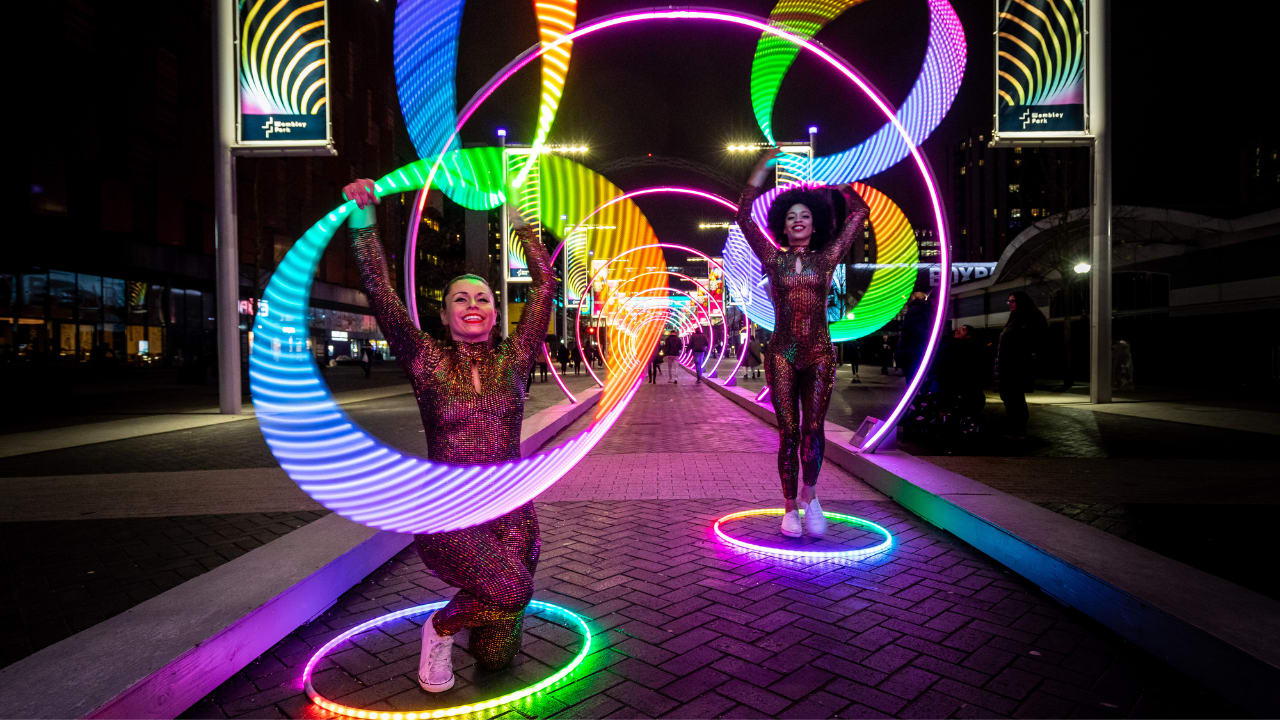Interactive Art: A catalyst for urban revival and community engagement
Photo credit: Sonic Runway by Rob Jensen & Warren Trezevant © Chris Winter - Wembley Park
By Alexandre Lemieux, Director Business Development and Co-founder, Creos
As we live in the age of experiences, the field of placemaking is poised for exciting developments, and we find ourselves at the edge of potential transformations that could redefine our urban landscapes and communal experiences.
Navigating new economic shifts there's a growing need worldwide for affordable entertainment. We see cities and towns using art and technology to transform their public spaces into places of convergence and human connection. Multi-sensory experiences are being used to entice audiences back to city centres, energizing urban areas and encouraging safe, immersive, social experiences to reframe how we live now. Against this backdrop, our experiences with many public place managers testify that temporary art initiatives, especially playful ones, can have an enormous impact in both the short and long term.
An exciting study from The Creative School at Toronto Metropolitan University, The Daniels Corp., Lemay, Entro, and MASSIVart1 presented 598 participants with office spaces, outdoor courtyards, lobbies, and transit stations to measure the difference in responsiveness to locations with and without placemaking interventions. The study found that at locations with interventions, key engagement metrics increased:
- +50% in time spent at a location with placemaking interventions
- +53% in positive perception of the environment
- +77% in the likelihood for individuals to share information about the location
- +63% in positive feelings about the environment
- +53% in self-congruity [forming a sense of connection between the individual and the location]
Another report, released by ICSC2 shows that 65% of consumers will increase their frequency of visits and overall expenditures at retailers that provide exceptional experiences.
Keeping in mind that any interaction generates a personal reaction, it becomes clear that the adoption of art in urban planning is not just an aesthetic choice; it's a strategic move towards creating immersive experiences that foster community engagement and stimulate local economies.
Revitalising urban areas and iconic landmarks
Creative placemaking through temporary artistic installations allows you to activate diverse spaces. By sparking unique and engaging experiences that help make places the talk of the town, we’ve seen that they are used as part of annual programming and outreach strategy in many ways. These initiatives have the potential to, furthermore, breathe new life into sometimes underutilised urban areas, turning them into a destination and points of pride for the community.
We have witnessed several success stories where artworks have activated or inaugurated new public spaces, new neighbourhoods, a new branding, arousing curiosity and creating a buzz around the event. Detroit’s Beacon Park certainly is one of these success story examples. Opened in July 2017, it features stunning light installations, an open lawn space, and a contemporary two-story restaurant. The park hosts a programme of daily organised activities, from musical performances and children’s events to art installations, local markets, and more. Beacon Park serves as a magnet for the community – attracting over 3 million visitors since its opening – spurring new development in surrounding businesses.
This highlights the role that art plays in the identity and revitalisation of cities, shaping their cultural landscape and reinforcing their unique character.
But how can we craft spaces that resonate across cultural and social spectra? The goal seems to be creating environments where inclusivity is the norm, not an afterthought, ensuring that everyone can find their place and their story within these public places.
Engaging the community: Beyond physical presence
Imagine spaces where people from diverse ages and backgrounds intersect, fostering unexpected and meaningful connections and dialogues. Interactive art serves as more than visual landmarks. By utilising technology, storytelling, and stimulating senses, they invite individuals to play and actively participate in transforming the spaces they inhabit into memorable experiences.
Over time, many of our clients have observed that playful art attracts a diversity of age and race. Not only do they enhance the discourse about a space, but they also help communities in forging memorable moments and enduring social bonds.
In addition, these artworks offer limitless visually appealing content that can be enjoyed virtually by the masses. When coupled with social media coverage, they significantly enhance the visibility and public perception of destinations, as well as foster long-term brand awareness for neighbourhoods and cities, becoming a powerful promotional tool.
When the City of Hamilton wanted to attract people to its new Pier 8 as part of Hamilton's Waterfront, animating the space through placemaking and animation activities which includes temporary art was part of their main strategy. An Instagram Reel about the Sonic Runway installation surprised them all when it became their most watched Reel ever.
Through the presentation, they increased Instagram account followers by 20%. And while they did not pay for any social media influencers to cover the installation, a few decided to create videos on their own which became their most viewed Reel (173K views) or post with the highest engagement.
Supporting local businesses through artistic infusions
The synergy between public places activation and local businesses can create a mutually beneficial ecosystem, demonstrating once more the economic significance of integrating art into urban development.
A recent success story from one of our clients exemplifies this impact. Their goal was to provide a fun, safe, and engaging experience for their clientele while enhancing profits for local restaurants and tenants, generating quality PR, and creating a buzz on social media and among influencers. All these objectives were met, and at one of their properties, they observed a 31% increase in sales for full-service restaurants on their premises and a 5% increase in sales for merchants at another site.
Measuring impact: Success beyond the visual
Assessing the success of a temporary art presentation involves a multifaceted approach encompassing many different metrics. From quantifiable economic benefits and pedestrian traffic to more abstract social and cultural impacts, these evaluations demonstrate the comprehensive value that such projects bring.
In a marketing point of view, measuring public satisfaction allows for a better assessment of the social impacts in a public space and within the community, and the public's perception of a place. Surveying these social impacts not only justifies the initiative's benefits in the community but also enhances local visibility. Concurrently, tracking foot traffic directly quantifies impact and may allow for gathering information on the persona, aiding in targeting audiences, facilitating tailored future initiatives and messaging. Assessing economic impacts on local businesses further quantifies the initiative's benefits and garners their support for future endeavours.
Collecting web performance indicators plays a crucial role in quantifying outreach, strengthening initiative visibility and brand image, and securing community support for future projects. Some of our city partners have witnessed website visits increase by over 25% during certain events, with a sudden 20% spike in social media followers. Influencer videos have garnered hundreds of thousands of views within a few days in small communities.
Overall, data is a powerful tool that provides a clearer picture. It can help you develop strategies to improve the quality and type of experiences offered and enhance the reach and impact of your initiatives. These data not only allow you to assess and quantify success (and thus impact your brand image), but they also guide your future planning and strategies, budgeting, supporting your funding requests, and your communications with the community.
The transformative power of interactive art
Reflecting on the transformative power of interactive art, it becomes clear that these installations serve as essential catalysts for crafting vibrant, inclusive, and dynamic urban environments. Not only do they attract people, they also engage them as active participants. Embracing innovation and collaboration, they transcend cultural boundaries and enrich our communities.
We stand at the threshold of infinite possibilities for urban revitalisation and community engagement, as well as for imprinting positive place branding, enhancing their allure and desirability. As we embark on this journey, let us explore how we can pave the way for a future where our cities thrive as vibrant hubs of creativity, inclusivity, and connection.
Creos’s Alexandre Lemieux will be speaking at City Nation Place Americas 2024 with David Cowan, Chief Public Spaces Officer for Downtown Detroit Partnership, to explore how cities can leverage art installations to rejuvenate their places. Join us in Houston on May 14-15th to learn from Alexandre and David, along with leaders from more than 20 place brand and place marketing organisations from across the USA and Canada. See the full agenda here.
1 Augmenting places: The impact of placemaking on behavioural intentions
Report by MASSIVart, The Daniels Corporation, Lemay, Entro, and the Creative School at Toronto Metropolitan University
2 ICSC Marketplaces Industry Report, Q1-2023
The member organisation for industry advancement, ICSC promotes and elevates the marketplaces and spaces where people shop, dine, work, play, and gather as foundational and vital ingredients of communities and economies.









